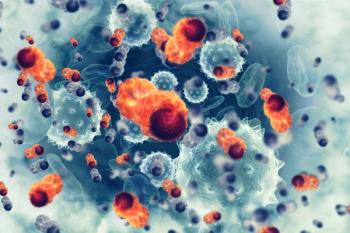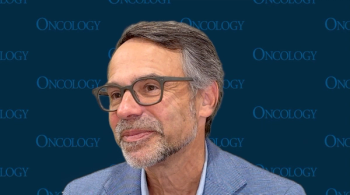
Oncology NEWS International
- Oncology NEWS International Vol 8 No 1
- Volume 8
- Issue 1
Formation of Fibrin Clots Key to Angiogenesis
WASHINGTON-The relation between tumor cell proliferation and angiogenesis is well known: Tumors need a supply of blood in order to grow beyond a depth of 1 mm. Discovering how angiogenesis works has been the focus of research by Harold Dvorak, MD, Mallinckrodt Professor of Pathology, Harvard Medical School.
WASHINGTONThe relation between tumor cell proliferation and angiogenesis is well known: Tumors need a supply of blood in order to grow beyond a depth of 1 mm. Discovering how angiogenesis works has been the focus of research by Harold Dvorak, MD, Mallinckrodt Professor of Pathology, Harvard Medical School.
Specifically, he is studying how tumor vessels become hyperpermeable, allowing fibrin, a key molecule in the process of angiogenesis, to get out of existing blood vessels and into tumor stroma.
To do that, two things have to happen. First, vessels have to be leaky so that fibrin can escape and, second, clotting has to take place. Both of these things happen regularly in tumors, Dr. Dvorak said at a basic science symposium sponsored by the National Foundation for Cancer Research, which supports his work.
Normally, adult human tissues are in balance with regard to blood supply; this balance discour-ages the growth of new blood vessels, Dr. Dvorak said. However, anything that causes vessel permeabilitysuch as wound healing or a tumorcan lead to fibrin leakage. Such leakage induces the formation of fibrin clots that encourage the development of new blood vessels.
Fibrin serves as a provisional matrix, imposing cell structure, regulating cell migration, and inducing formation of mature stroma, he said.
Dr. Dvorak reported finding a substance he calls vascular permeability factor (VPF), also known as vascular endothelial growth factor (VEGF), that can induce vessel permeability (see box ). Tumors have the ability to make and secrete VPF/VEGF, thus causing blood vessels to leak fibrin. Increased vascular permeability to circulating fibrin macromolecules converts the ordinarily neutral extracellular matrix to one that is proangiogenic, he said.
VPF/VEGF Shown to Promote Angiogenesis In Human Tissue
In order to study factors involved in tumor angiogenesis, Dr. Harold Dvorak and his colleagues have devised a method of starting the process in human tissue by incorporating vascular permeability factor (VPF/VEGF) into an adenovirus.
When the virus carrying VPF/VEGF is injected into muscle fibers, vessels become permeable and leak plasma proteins. This can produce considerable deposition of fibrin between muscle fiber bundles, Dr. Dvorak said. Such fibrosis replicates what happens in tumors.
With VPF/VEGF alone, he said, we can generate the type of vessels and stroma found in tumors. The next thing is to try additional cytokines to see if we can develop mature vessels of the kind found in normal adult tissue. This type of vessel would be most useful for helping patients with tissue ischemia. Also, such vessels, having normal vascular permeability, would not be expected to support tumor growth.
Wound healing also induces production of VPF/VEGF. However, tumors differ from healing wounds in one important respect. As soon as a wound is healed, VPF/VEGF production is turned off abruptly. Tumors, however, continue to make large amounts of VPF/VEGF because they are growing rapidly and need a new blood supply.
How do circulating macromolecules like fibrin get out of blood vessels? Dr. Dvorak said that various explanations have been proposed. The most popular explanation is that they pass through interendothelial spaces or junctions. Alternatively, a small lipid may dissolve the endothelial membrane. Or perhaps a fenestrated type of endothelium forms, one with a thin membranea pattern characteristic of endocrine tissues, he said.
In the 1950s, Dr. Dvorak noted, George Palade described a structure called a caveola, which forms a small pocket in the endothelium and then migrates across the vessel wall to discharge its contents.
Although the vast majority of tumor endothelium is continuous, Dr. Dvorak described grape-like clusters of interconnecting vessels and vacuoles of varying size, which he calls vesiculo-vacuole organelles (VVOs). They form very large structures, occupying 20% of the endothelial cytoplasm. These VVOs are joined by diaphragms and span the entire thickness of the endothelial lumen, with multiple openings to each surface. Dr. Dvorak believes they play an important role in transmitting fibrin molecules across the endothelium to begin angiogenesis.
Articles in this issue
almost 27 years ago
Pittsburgh to Build New Cancer Centeralmost 27 years ago
NCI Initiates Two High-Priority Tobacco Research Programsalmost 27 years ago
Breast Cancer Stamp Sells Wellalmost 27 years ago
Hospital Strategies To Prevent Invasive Aspergillosis Spreadalmost 27 years ago
‘Cancer Patients Should Be Assertive, Know Their Rights’almost 27 years ago
EBCTCG Update of Adjuvant Treatment for Early Breast Canceralmost 27 years ago
Younger Breast Cancer Patients at Increased Risk of Recurrencealmost 27 years ago
Six Named to National Cancer Advisory Boardalmost 27 years ago
Trial Uses Vitamin A To Prevent Lung Cancer in Former Smokersalmost 27 years ago
‘Medical School Curriculum Must Include Palliative Care’Newsletter
Stay up to date on recent advances in the multidisciplinary approach to cancer.
















































































